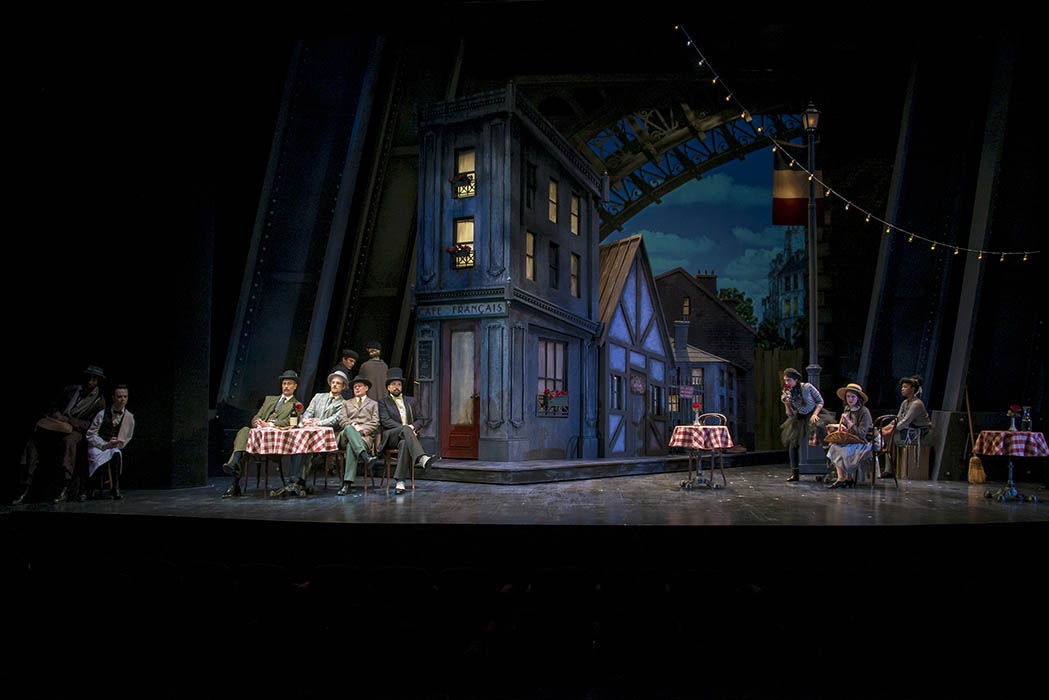Ending the season with a large and colorful bang has generally been the modus operandi for the Clarence Brown Theatre, closing out with a season finale production that pulls out all the stops with a visual and aural feast for the eyes and ears that supports a large cast and dynamic, energetic performances. That is certainly the case with the current one—Jean Giraudoux’s The Madwoman of Chaillot. However, those season-closers have also often possessed another common thread—a cautionary, if not prophetic narrative—seemingly intended to make a contemporary connection to relevant socio-political issues. That, as they say, is The Madwoman of Chaillot all over.
Written by Giraudoux during the height of World War II, but not performed until the end of 1945, almost two years after his death, the play’s gentle comedy paints a condemnation of the evils of industrialization and of the evils of humanity that seem to accompany it. Despite the seriousness of the theme, Giraudoux’s style is lyrical, whimsical, and poetic, a style that gives the work a sense of allegory and fable woven with threads of delicious and captivating language. The work seems unbelievably prescient in its focus; if one did not know of its origins, one might assume it was written with our current world in mind.
In a translation from 2014 by Laurence Senelick, the play relates the tale of a group of neighborhood Parisians and their eccentric leader, a “Countess” Aurelie, known as the Madwoman of Chaillot. The group learns of a plan by a collection of grossly insensitive, greedy, and crooked businessmen to drill for oil under the city of Paris, thus destroying it for the sake of profit. Aurelie and a collection of neighborhood people concoct a plan to thwart the businessmen using their own greed as bait, symbolically ridding the world of evil and its cruelty.
Directed by Paul Barnes (2015’s Of Mice and Men at CBT) with both broad brushstrokes and clever subtle details, the production features a diverse cast of over 30 actors in the usual mix of visiting professionals, UT Theatre faculty members, MFA actors, and undergrads. Leading the cast is CBT artist-in-residence Carol Mayo Jenkins as Aurelie, the guiding force behind the Chaillot residents. Ms. Jenkins’ delivery is one of honey on a crisp baguette, a soft lyricism with a rhythmic edge that draws the listener into every word and phrase. Of course, there is nothing mad at all about Jenkins’ Aurelie; perhaps she is the sane one in an insane world. Her fantasies are tangible and textural, and she seems to know full well what is real and what is illusion.

The Chaillot residents seem to transcend their apparent station in life, pictured by Giraudoux as fundamentally honest, if simple people, their character names representing their honorable role in society. The Ragpicker (in a notably fine performance by Jade Arnold) possesses an uncanny eloquence and intelligence that leads to his representation of the businessmen in a mock trial that sums up the play’s arguments. Rescued from the evil machinations of the businessmen, Pierre (Brady Moldrup) is paired with the lovely and bright dishwasher, Irma (Gracie Belt), the two symbolizing the power of transformation. Displaying a definite flair for visual acting were The Street Singer (Brittany Marie Pirozzoli) and The Deaf Mute (Owen Squire Smith).
Giraudoux wastes no time in introducing the evil businessmen to the audience, each one getting a deliciously nasty opportunity to relate their qualifications as the inhumane segment of society: Terry Weber as the Chairman of the Board, Brian Gligor as The Baron, Collin Andrews as The Stock-Broker, and David Brian Alley as The Prospector.
In Act II, Aurelie summons her fellow madwomen for advice and assistance, scenes that were bright and energetic thanks to marvelous performances by Tarah Flanagan (as the bubbly Constance), Carolyn Popp (as Gabrielle), and Katie Cunningham (as the wacky, but judicious, Josephine).
In a very satisfying season-finale scale, scenic designer Christopher Pickart has given us a lot to look at (along with Collin Hall’s projections), from the gorgeously asymmetric Chaillot street scene of Act I to a marvelous Countess Aurelie’s basement residence in Act II that seems to be the gateway to hell for those greedy individuals that sought to destroy. Lighting designer Alice Trent gave Pickart’s set and Barnes’ staging layers of focus that painted the scenes with highlights and depth. Erin Reed’s costumes, from the spectacularly showy dresses of the Madwomen, to the honestly grungy street clothes of the Chaillot cafe denizens, were everything one expected.
While destroying all the evil in the world may seem like a futile endeavor, Giraudoux seems to suggest that there are ways. In a spirit of optimism Aurelie offers, “Nothing is ever so wrong in this world that a sensible woman can’t set right in the course of an afternoon.” In this, Giraudoux was amazingly prescient—if only we could learn that lesson.
• • • • • • • • • • • •







